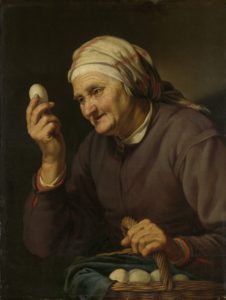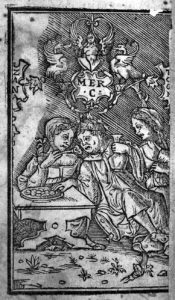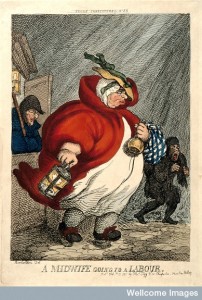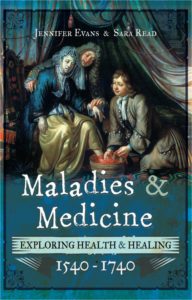
In my current project on men’s sexual health (including genitourinary conditions and afflictions of the groin) I have been reading a lot of descriptions and case notes of testicular swellings and hernias. One of the things that has stood out to me and intrigued me is the use of comparisons to explain how big swellings are.
In cases of kidney and bladder stones were sometimes measured and weighed – presenting, purportedly, accurate descriptions of their size. John Middleton’s 1727 treatise A Short Essay on the Operation of the Lithotomy, for example, described the stone removed from 15-year-old Benjamin Milson, as ‘a small long Stone, with several rough Knobs on it, and weigh’d Half an Ounce’.[1] When hernias became particularly large and came to the attention of particular interested parties they might also be described in a similar way. The Royal Society of London Philosophical transactions reported on John Hollowday’s hernia in 1766. They claimed that when he died in the hernia measured 15 inches from top to bottom and 17 and a 1/2 inches at its widest point. It was 34 inches in circumference. [2] This was accompanied by an image of the extensive swelling.
This wasn’t always the case, though. Instead medical writers employed an extensive comparative vocabulary to describe things removed from the body, and bodily swellings.
Some stones were described in relation to beans and peas. Mattheus Gottfried Purman noted that in the late seventeenth century ‘Baron Von Horst Lieutenant Colonel of the Hannover Troops’ had kept his bladder stones and readily showed them to interested parties, himself included: ‘in the year of 1687 shewed me a great Box full of Angular, Oval and Round Stones which came from him in Six Weeks Time, the largest whereof was about the bigness of a great Pea’.[3] Others in relation to other natural objects.

John Middleton, seen above, described the stone removed from 45-year-old Somerset resident Joseph Segar as ‘near the Bigness of a Duck’s Egg’.[4] Similar descriptions were also used for hernias and swellings. Daniel Turner described one ‘young Infants’ Hydrops Testis (watery swelling of the testicle) as being ‘as large as a Pigeon’s Egg’. He noted in another case that a ‘poor old French Man in Spittlefields‘ had a fleshy tumour in his testicles the ‘Dimensions of a common Foot-Ball’.[5]
Medical writers also commonly compared phenomena to other parts of the body. William Beckett described the stones removed from the bladder of an eighteen year old man as being ‘as big as a Child’s Fist’. [6] These comparisons may not have been the most accurate but perhaps present a much more compelling, shocking, or interesting description. The English translation of Barthélemy Saviard’s Observations in Surgery described a man suffering from a hydrocele (watery swelling of the scrotum) as follows,
The Tumour was as big as the Head of a Child, and considerably hard. [7]
We of course might ask, how old was this supposed child as this might change the size of the tumour. Accuracy clearly was not the desired result of this description. In a previous post of the dangers of horse riding we saw that John Hester described how ‘A Certaine man, riding on a trotting horse, had his stones swolne, as big as one fist’ (caused presumably by crushing and bruising).[8] Again while this description is useful for offering an immediate sense of scale, it is not useful when you consider the variety in people’s hand size.
These descriptions offer an immediate yet ultimately unreliable sense of the size of stones and hernias. But they tell us something about the ways in which the writers of these texts perceived their readers. It is plausible that they expected some to be innumerate. Keith Thomas has explored numeracy in this era and suggests that it is difficult to assess how numerate people were because numeracy leaves few traces.[9] Most people could count but it is difficult to assess how many people were familiar with complex mathematics. We could think this might apply to measurements as well. He has pointed out that medical practitioners still used measurements like ‘a handful’.[10] Therefore, these vague but recognisable descriptions were of more practical use than lists of numbers.
__
[1] John Middleton, A short essay on the operation of lithotomy: as it is performed by the new method above the os pubis (London, 1727), p. 26.
[2]Philip R. Mills ‘Privates on Parade: Soldiers, Medicine and the Treatment of Inguinal Hernias in Georgian England’ in Ed. Geoffrey L. Hudson British Military and Naval Medicine, 1600-1830 (Clio Medica 81) The Wellcome Series in the History of Medicine Amsterdam and New York (2007), pp, 149-182, at p, 149.
[3] Mattheus Gothofredus Purmannus, Chirurgia Curiosa: Or, The Newest and most Curious Observations and Operations in the Whole Art of Chirurgery (London, 1706), p. 146.
[4] Middleton, A Short Essay, p. 27.
[5] Daniel Turner, The art of surgery: in which is laid down such a general idea of the same, as is … confirm’d by practice (London, 1722), p. 228, 249.
[6] William Beckett, Practical Surgery Illustrated (London, 1740), p. 157.
[7] Barthélemy Saviard, Observations in Surgery (London, 1740), pp. 58-9
[8] John Hester, The pearle of Practice, or Practisers pearle, for phisicke and chirurgie (London, 1594), p. 23.
[10] Ibid, p. 122.




One thought on “Metaphorical Magnitude”
Comments are closed.